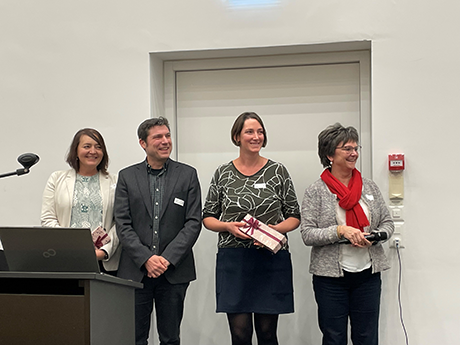MIC Symposium 2023

The MIC Symposium was held in 2023 on November 17th with the theme “New Trends in Microscopy”.
The meeting was kicked off with a welcome address by Aurel Perren, the Deputy Dean of the Medical Faculty, and the exciting announcement by Britta Engelhardt, the president of the MIC, that the MIC was recently recognized as one of the five "official" core facilities of the University of Bern.
We moved on to the first session of our scientific program where we were introduced to methods by which single cells can be visualized in their large global context. Gail McConnell from the University of Strathclyde, UK presented optical imaging with the mesolens, a giant microscope objective that allows full 3D recording of many thousands of cells and amazed us by 3-D printing the lenses they use in their system. Thomas Nevian, Physiology, UniBern followed with his cutting edge work on how in vivo miniscopes can image single cell activity of neuronal cells in the brain of freely moving animals.
The second session took a bit of a turn to introduce how various ‘’omic’ technologies can be combined with imaging to provide spatial context of large proteomic, transcriptomic and metabolomic data sets. The session began with a talk by Hannah Williams, Institute of Tissue Medicine and Pathology (IGMP), UniBern who is coordinating the local Spatial Omics Consortium (SPOC, https://spoc-bern.squarespace.com) for those interested in the techniques and the latest developments in spatial omics. Joel Zindel, Visceral Surgery, UniBern presented his research on how he used spatial transcriptomics to identify new factors in abdominal adhesion formation. The session was concluded with a talk by from Daniel Schulz, Dept of Quantitative Biomedicine, UniZürich, in which he presented how imaging mass cytometry can be used to characterize protein and RNA in the tumor microenvironment and how this is used to compare 1000s of patient samples within the “Integrated iMMUnoprofiling of large adaptive CANcer patient cohorts” (IMMUcan) Consortium.
In our final session we had fascinating talks on new advances in super resolution and expansion microscopy. Paul Guichard, UniGeneva introduced us to the possibility of using expansion microscopy to increase the resolution of the molecular architectures by enlarging cells in a polymer matrix. Subcellular resolution imaging can then be achieved with conventional diffraction limited microscopes. The meeting was closed with an outstanding talk from Stefan Hell, Max-Planck-Institute, Germany in which he shared the history of developing super resolution microscopy that awarded him a Nobel prize and how he is continuing to develop the MINFLUX super-resolution microscope.
This year’s MIC symposium was a success due to the excellent speakers, and also from the excellent preparation by the MIC administration and our student helpers. And last, but not least due to the generous support we received from our industrial sponsors. The event was fully booked weeks in advance with over 200 registrations.
The scientific committee, Kerry Woods, Deborah Stroka, Thomas Nevian hope all attendees enjoyed the program and got an insight into new microscopy technologies that enable a more detailed look into the complexity of tissues and cells. Find more impressions here.
